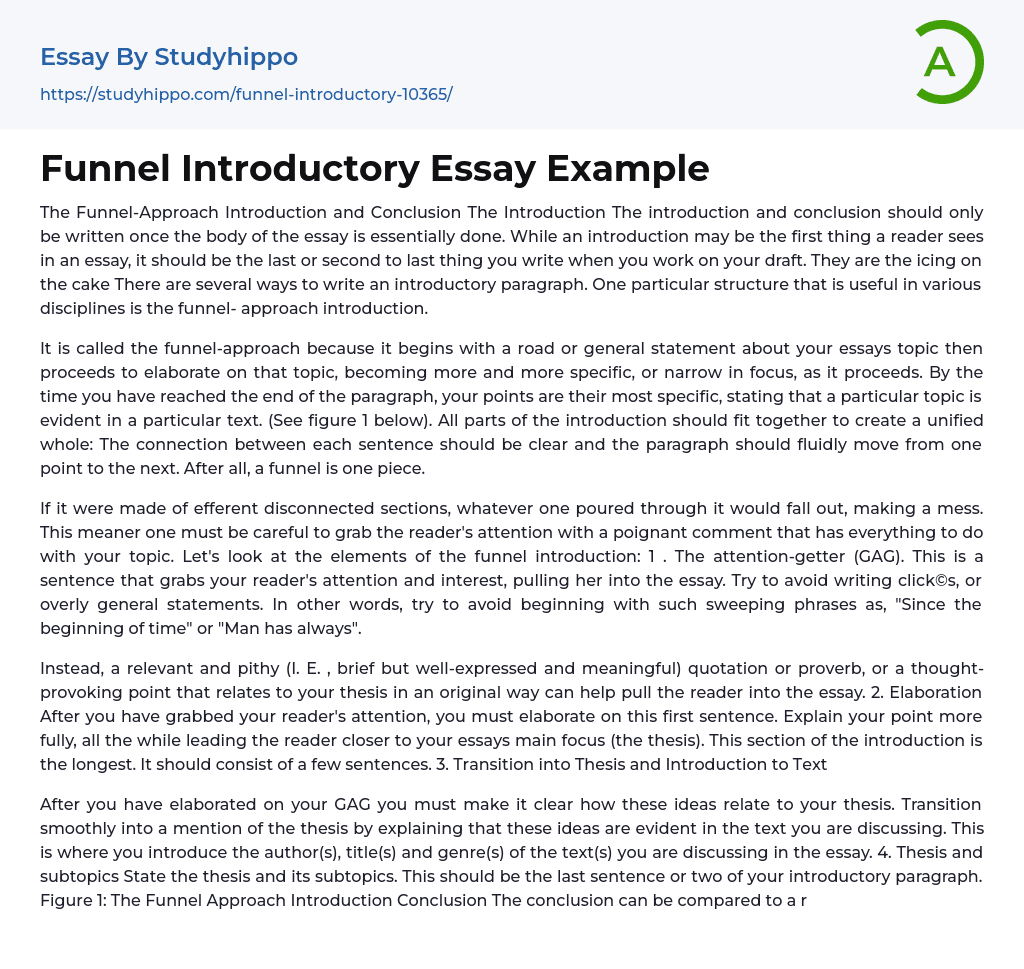The Funnel-Approach Introduction and Conclusion The Introduction The introduction and conclusion should only be written once the body of the essay is essentially done. While an introduction may be the first thing a reader sees in an essay, it should be the last or second to last thing you write when you work on your draft. They are the icing on the cake There are several ways to write an introductory paragraph. One particular structure that is useful in various disciplines is the funnel- approach introduction.
It is called the funnel-approach because it begins with a road or general statement about your essays topic then proceeds to elaborate on that topic, becoming more and more specific, or narrow in focus, as it proceeds. By the time you have reached the end of the paragraph, your
...points are their most specific, stating that a particular topic is evident in a particular text. (See figure 1 below). All parts of the introduction should fit together to create a unified whole: The connection between each sentence should be clear and the paragraph should fluidly move from one point to the next. After all, a funnel is one piece.
If it were made of efferent disconnected sections, whatever one poured through it would fall out, making a mess. This meaner one must be careful to grab the reader's attention with a poignant comment that has everything to do with your topic. Let's look at the elements of the funnel introduction: 1 . The attention-getter (GAG). This is a sentence that grabs your reader's attention and interest, pulling her into the essay. Try to avoid writing click©s, or overly
general statements. In other words, try to avoid beginning with such sweeping phrases as, "Since the beginning of time" or "Man has always".
Instead, a relevant and pithy (I. E. , brief but well-expressed and meaningful) quotation or proverb, or a thought-provoking point that relates to your thesis in an original way can help pull the reader into the essay. 2. Elaboration After you have grabbed your reader's attention, you must elaborate on this first sentence. Explain your point more fully, all the while leading the reader closer to your essays main focus (the thesis). This section of the introduction is the longest. It should consist of a few sentences. 3. Transition into Thesis and Introduction to Text
After you have elaborated on your GAG you must make it clear how these ideas relate to your thesis. Transition smoothly into a mention of the thesis by explaining that these ideas are evident in the text you are discussing. This is where you introduce the author(s), title(s) and genre(s) of the text(s) you are discussing in the essay. 4. Thesis and subtopics State the thesis and its subtopics. This should be the last sentence or two of your introductory paragraph. Figure 1: The Funnel Approach Introduction Conclusion The conclusion can be compared to a reverse or upside-down funnel.
It should begin restatement". You don't want to sound repetitive, and it is always helpful to express your main argument in a different way to help your reader better grasp it. After rewording the thesis, you can remind your reader of the main sub-points of your argument, again rewording rather than simply restating them. Finally, you can relate
the argument to life in general. What are the implications of the argument? Are there any interesting insights which analyzing the text has given you? Cab you offer any predictions or, if your essay addressed a problem, a solution?
One should avoid introducing new arguments or claims about the text(s) analyzed in a conclusion, because your reader will simply want proof of these new claims and a conclusion is not the place to begin analyzing the text all over again. Instead, you are summing up your argument, Just as a lawyer will offer a final summation of his case for a Jury. A good lawyer will try to end his summation with a thought-provoking or insightful comment that helps highlight the main argument. This thought-provoking point should be the final sentence or two in your conclusion.
- Mean essays
- Nightclub essays
- Book Summary essays
- Metaphor essays
- Reader essays
- Rhyme essays
- Literary devices essays
- Villain essays
- Books essays
- Genre essays
- Literary Criticism essays
- Writer essays
- Protagonist essays
- Simile essays
- Poem essays
- Book Report essays
- Book Review essays
- Greek Mythology essays
- Plot essays
- Tragic Hero essays
- Coming of Age essays
- Play essays
- Rhetoric essays
- Rhetorical Question essays
- Translation essays
- Understanding essays
- Reason essays
- Character essays
- Letter essays
- American Literature essays
- Literature Review essays
- Utopia essays
- Poetry Analysis essays
- Dante's Inferno essays
- Between The World and Me essays
- Incidents in The Life of a Slave Girl essays
- Flowers for Algernon essays
- Myth essays
- Everyday Use essays
- Boo Radley essays
- Genesis essays
- Richard iii essays
- Alice in Wonderland essays
- On the road essays
- Ozymandias essays
- The Nightingale essays
- Holden Caulfield essays
- Animal Farm essays
- 1984 essays
- A Hanging essays




